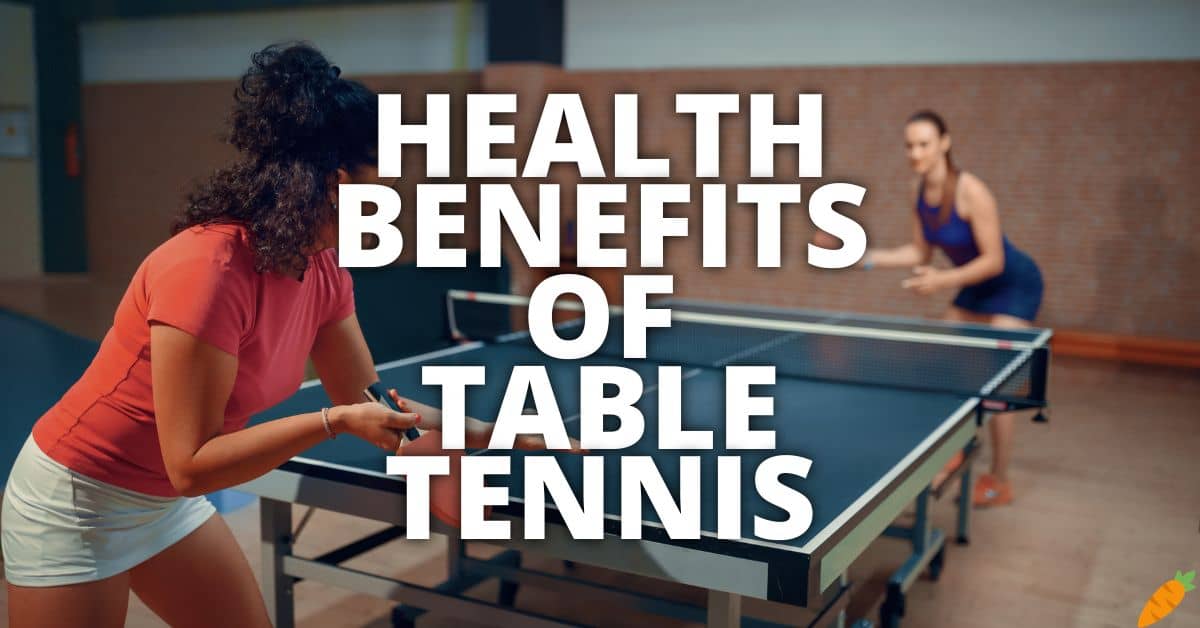It’s a lovely day to discuss the potential health benefits of table tennis.
🤔 What is table tennis?
Table tennis, also known as ping pong, is a sport in which two or four players hit a lightweight ball back and forth using small paddles.
A net separates the game’s playing area from a rectangular table.
Players must serve the ball and aim to make it land on the opponent’s side of the table.
Points are scored when a player fails to return the ball, hits it out of bounds, or commits other mistakes.
The objective is to score more points than the opponent, typically up to 11 or 21 points, depending on the format.
📝 Here’s a list of the potential health benefits of table tennis:
- Heart Health
- Enhanced Reflexes
- Burning Calories
- Healthier Joints
- Mental Sharpness
- Better Hand-Eye Sync
- Relief From Stress
- Improved Stability And Quickness
- Building Social Connections
- Total Body Exercise
- Quicker Response Time
If you want to learn more, please continue reading.
1. Cardiovascular Health
Cardiovascular health refers to the well-being of the heart and blood vessels.
Playing table tennis regularly promotes better circulation and increases the heart rate, akin to moderate aerobic exercise.
As the heart pumps faster, it strengthens and becomes more efficient over time.
This can reduce the risk of heart-related diseases and improve overall cardiovascular endurance.
Engaging in activities like table tennis can be a fun and effective way to maintain a healthy heart.
2. Improved Reflexes
Reflexes are our body’s instant reactions to specific stimuli.
In table tennis, players face rapid ball exchanges, requiring swift decisions and actions.
As players practice and play, their ability to react quickly improves, honing their reflexes.
Over time, these sharpened reflexes not only benefit gameplay but can also be advantageous in daily activities that demand quick reactions.
Thus, playing table tennis can help enhance an individual’s overall response time to various situations.
3. Calorie Burning
Calories are units of energy that our body uses for its functions, and burning them helps maintain or reduce weight.
Table tennis involves constant movement, such as running, lunging, and twisting, which raises the body’s energy expenditure.
As players engage in these activities, they burn calories.
Regularly playing the sport can contribute to a caloric deficit, which is essential for weight loss.
Therefore, table tennis serves as an enjoyable way to keep fit and manage one’s weight.
4. Joint Health (My Favorite Potential Health Benefit Of Table Tennis) ⭐️
Joints connect bones and allow movement, and their health is crucial for mobility.
Low-impact sports, like table tennis, reduce the risk of placing undue stress on these joints, especially the knees, hips, and ankles.
This gentleness makes it a suitable activity for individuals of all ages, including those with concerns about joint wear and tear.
While it’s easier on the joints, table tennis still demands movement and agility, ensuring the joints remain active and flexible.
Engaging in this sport can thus promote joint health without causing excessive strain.
Of course, this changes when you’re engaged in high-level table tennis competitions.
5. Mental Acuity
Mental acuity refers to the sharpness of the mind and its ability to think clearly.
Table tennis demands players stay focused on the ball and anticipate their opponent’s moves, enhancing concentration levels.
The sport also requires devising tactics to outsmart the opponent, stimulating strategic thinking.
Quick decisions are essential, as players must decide in split seconds where to place the ball or how to counteract a shot.
Therefore, regular play can sharpen the mind, boosting cognitive functions and overall mental agility.
6. Improves Hand-Eye Coordination
Hand-eye coordination is the synchronized control of eye movement with hand movement.
In table tennis, players need to watch the ball closely and respond with accurate paddle strikes.
This constant tracking and responding trains the eyes and hands to work together efficiently.
Over time, as players adjust to the ball’s speed and direction, their hand-eye coordination improves.
Such enhanced coordination can be beneficial in many daily tasks and other sports, making table tennis a valuable activity for refining this skill.
7. Stress Reduction
Stress is a common issue in today’s fast-paced world, and finding ways to manage it is crucial for well-being.
Table tennis offers an engaging distraction from daily worries, allowing players to immerse themselves in the game.
As they play, their bodies release endorphins, which are natural chemicals known as “feel-good” hormones.
These endorphins can help alleviate feelings of stress and elevate mood.
Thus, indulging in a session of table tennis can provide both physical and emotional relief, making it an enjoyable form of stress reduction.
8. Balance And Agility
Balance and agility are key components of physical fitness, relating to one’s ability to control body movements and react swiftly.
In table tennis, players are constantly on the move, shifting positions to return shots.
This requires maintaining stability on their feet while adjusting to the ball’s direction.
Such dynamic movements not only improve agility, allowing players to move quickly and with precision, but also enhance balance, ensuring they remain steady during play.
Over time, practicing these skills in table tennis can contribute to better overall physical coordination and dexterity in daily life.
9. Social Interaction
Human beings are inherently social creatures, and connecting with others is vital for emotional well-being.
Table tennis, whether played in singles or doubles, offers an opportunity for interaction.
Players communicate, compete, and often share feedback or laughs, building camaraderie.
Participating in such activities can strengthen bonds, making individuals feel more connected and less isolated.
In essence, table tennis provides both a physical and social outlet, helping to nurture relationships and enhance one’s sense of community.
📚 Ping Pong For Health: The Meaning Of Space In A Sport Based Health Intervention At The Workplace
10. Full-Body Workout
Table tennis is more than just a game of paddles and a ball; it’s a whole-body activity.
The legs provide the foundation, constantly moving players into position, which offers a good lower-body workout.
The core, or midsection, engages as players twist and turn to reach for shots, strengthening abdominal muscles.
The arms, on the other hand, are vital for striking the ball, giving them a consistent workout.
As a result, even a short game can activate and exercise various muscle groups, making table tennis an effective full-body workout.
11. Improved Reaction Time
Reaction time is the speed at which a person responds to a specific stimulus.
In table tennis, the swift movement of the ball requires players to react almost instantaneously.
As players train and become more accustomed to the game’s pace, their ability to respond quickly sharpens.
This heightened responsiveness isn’t just limited to the game; it can translate to faster reactions in daily scenarios, like avoiding obstacles while walking or reacting to sudden changes while driving.
Consequently, table tennis not only enhances in-game performance but also bolsters quick thinking in routine activities.
💡 Conclusion
Table tennis, often perceived as just a recreational game, holds a plethora of health benefits for players of all ages.
It offers a comprehensive workout that engages both the mind and body, from enhancing cardiovascular health to sharpening mental acuity.
The sport promotes agility, balance, and improved hand-eye coordination, all while serving as a social avenue for interaction and bonding.
Furthermore, its low-impact nature ensures that it remains accessible and beneficial even for those with joint concerns.
Overall, table tennis is not just a game of skill and strategy but a holistic activity that can contribute significantly to one’s well-being.
😊 My favorite potential health benefit of table tennis is its support for joint health.
Given its low-impact nature, the sport doesn’t exert excessive strain on the joints, making it particularly beneficial for someone like me dealing with arthritis.
Engaging in table tennis can help improve mobility and reduce stiffness, providing relief from arthritis-related discomfort.
Interestingly, table tennis originated in the late 19th century as an indoor adaptation of lawn tennis and was initially played using books as rackets and a rounded cork as the ball.
It’s amazing to think that this fun game, with such humble beginnings, offers notable health advantages, especially for joint care.
What’s your favorite potential health benefit of table tennis?
😎 You can also read articles about the potential health benefits of other sports here.
Please share this article with your family and friends if you find it useful.
Thank you!
Be healthy 💪 and stay safe 🦺!
⛑️ Safety First
While table tennis offers potential health benefits, it’s essential to approach it with caution, especially for individuals with pre-existing health conditions or those recovering from injuries.
Some of the touted benefits may be based on anecdotal evidence, so it’s crucial to differentiate between well-established facts and personal experiences.
Before diving into the sport, especially if aiming for therapeutic reasons, it’s highly recommended to consult with a doctor or medical professional.
Always do your own research and seek guidance from professionals when considering table tennis for health benefits.
Remember, everyone’s body is different, and what works for one may not be suitable for another.
📋 Summary
| Potential Health Benefits Of Table Tennis | Details |
| Cardiovascular Health | Boosts cardiovascular activity, promoting a healthy heart and improved circulation. |
| Improved Reflexes | The sport’s fast-paced nature requires swift reactions, honing reflexes over time. |
| Calorie Burning | Engaging in play increases energy expenditure, helping burn calories. |
| Joint Health | Being a low-impact sport, it’s gentle on the joints, making it suitable for all ages. |
| Mental Acuity | Enhances concentration, tactical strategy, and quick decision-making skills. |
| Improves Hand-Eye Coordination | Demands synchronization of visual input and hand motor skills, refining coordination. |
| Stress Reduction | Playing releases endorphins, which can reduce stress and improve mood. |
| Balance And Agility | Players move rapidly and maintain balance, enhancing overall agility and stability. |
| Social Interaction | Engaging with other players fosters connections and reduces feelings of loneliness. |
| Full Body Workout | Involves movements from the legs, core, and arms, providing a comprehensive workout. |
| Improved Reaction Time | The quick nature of the game sharpens overall reaction time, which is beneficial in various situations. |
⚠️ Content Disclaimer
The information provided in this content is for general informational purposes only.
It is not intended as, nor should it be considered a substitute for, professional advice, diagnosis, or treatment.
Always consult with a qualified professional or specialist before making any decisions based on the content.
The author and publisher disclaim any responsibility for any adverse effects or consequences resulting from the use or application of the information contained herein.
Readers are advised to exercise caution and not rely solely on this content without independent verification.

